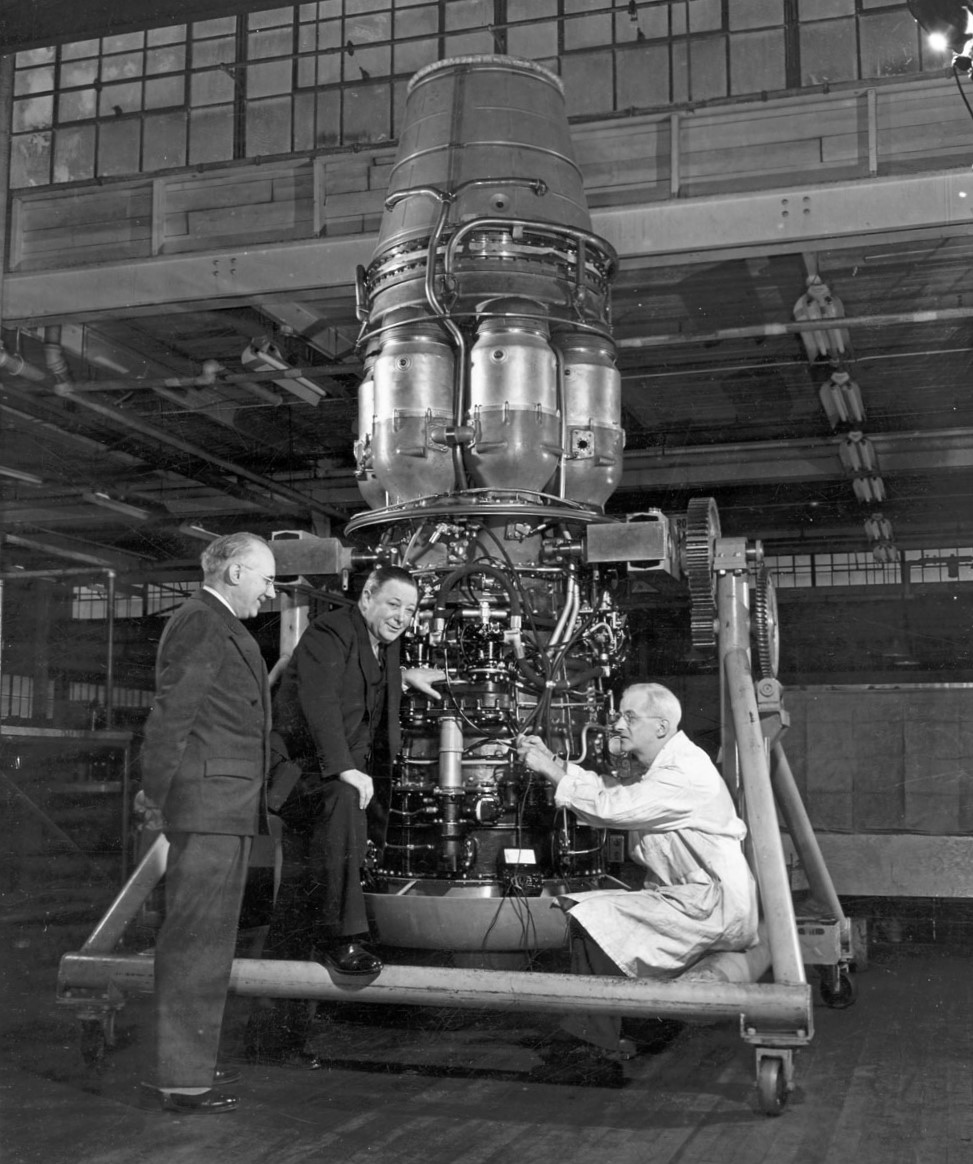Classic Historical Canadian Science and Technology Photos
Canadian Science and Technology

(Library and Archives Canada Photo, MIKAN No. 4047131)
Sir Frank S. Spriggs, Sir Roy Dobson, and a technician examining an Orenda jet engine, 1949.
In 1946, Avro Canada asked their technicians to produce a new 6,500 lbf (28.9 kN) engine for their CF-100 Canuck interceptor design, which became the TR.5 Orenda engine. Prototype production was completed in less than a year, and the engine first ran in February 1949. Testing of the prototypes ran over 1,000 hours, a record for the era. When it entered production it was the most powerful engine in the world, a title it held until 1952. Almost 4,000 Orenda engines of various versions were built by the time the final unit was delivered to the RCAF in July 1958. The Orenda entered production for the CF-100. Later versions of the Canadair CL-13 Sabre also used the Orenda, providing a dramatic boost in performance. (Wikipedia)

(Library and Archives Canada Photo, MIKAN No. 4365606)
Defence Research Board technicians at the Canadian Armament Research and Development Establishment, in Val Cartier, Quebec, readying a satellite prototype for a test, ca 1961. Alouette 1 was launched via Thor-Agena-B two-stage rocket by NASA from the Pacific Missile Range at Vandenberg Air Force Base, California, USA at 06:05 UTC on September 29, 1962, into orbit around Earth. The 145.6 kilograms (321 lb) satellite was placed into an almost circular orbit with an altitude of 987 kilometres (613 mi) to 1,022 kilometres (635 mi) with an inclination of 80.5°. The launch made Canada the third nation, after the USSR and the United States, to design and construct its own satellite. Alouette was used to study the ionosphere, using over 700 different radio frequencies to investigate its properties from above.
Alouette 1 was a Canadian satellite that was launched in 1962 to study the ionosphere. It was Canada's first satellite, and the first satellite constructed by a country other than the USA, Russia or Britain. Canada was the fourth country to operate a satellite, The name "Alouette" came from the French for "skylark".
A key device on Alouette were the radio antennas consisting of thin strips of beryllium copper bent into a slight U-shape and then rolled up into small disks in a fashion similar to a measuring tape. When triggered, the rotation of the satellite created enough centrifugal force to pull the disk away from the spacecraft body, and the shaping of the metal caused it to unwind into a long spiral. The result was a stiff circular cross-section antenna known as a "STEM", for "storable tubular extendible member".
Alouette's mission lasted for 10 years before the satellite was deliberately switched off on 30 September 1972. The satellite remains in orbit; in 1966 it was estimated that Alouette 1 would remain in orbit for 1000 years. (Wikipedia)

(Library and Archives Canada Photo, MIKAN No. 4949506)
Royal Astronomical Society of Canada (RASC) astronomer Malcolm M. Thomson inserts a photographic plate into a camera mounted on a large telescope housed in the Department of Mines and Technical Surveys Dominion Radio Astrophysical Observatory, Ottawa, Ontario, in 1959. The Observatory was officially opened on 22 June 1960. The Observatory remains a notable landmark on the grounds of the Central Experimental Farm National Historic Site of Canada, a short walk down the street from the Canada Agricultural and Food Museum in Ottawa.
The very first building constructed as an observatory in Canada was at Louisbourg, Cape Breton, but it was only used for a year before the astronomer, Joseph Bernard Chabert, returned to France in 1751. In the eighteenth and nineteenth centuries the British military, primarily the Royal Navy, also carried out astronomical observations to improve hydrographic maps in eastern and central Canada. In addition several observatories were built at universities, beginning with the University of New Brunswick in 1851, to instruct students in navigation, surveying and natural phenomena. By century’s end, astronomy was being taught as a scientific discipline in its own right.
Government astronomy in Canada, following Confederation in 1867, was primarily associated with surveyors who needed a means to determine the difference in longitude between their location and Greenwich, England, or Cambridge, Massachusetts—a very challenging exercise requiring highly accurate tables of the positions of astronomical objects and good astronomical instruments. Surveyors were hired by the Geological Survey of Canada (founded in 1841), the Hydrographic Survey (1880s), the Topographic Survey (1880s) and the Geodetic Survey of Canada (1909). Among other things, these astronomer/surveyors laid out boundaries between the United States and Canada, and between the Provinces.

(Library and Archives Canada Photo, MIKAN No. 3374204)
McIntyre Mine - (Surface) Main hoist 50-ton fly wheel - slip regulator on extreme right background. Schumacher, Ontario, 1936.

(Library and Archives Canada Photo, MIKAN No. 4948528)
Repairs being carried out on a Canadair CL-13 Sabre engine turbine blades in Toronto, Ontario in 1952.

(Library and Archives Canada Photo, MIKAN No. 4948519)
Harpoon!

(Library and Archives Canada Photo, MIKAN No. 4948982)
A student is taught how to fix a needle on a sweater-knitting machine, 1957.

(Library and Archives Canada Photo, MIKAN No. 4297752)
Sample being removed from the self-serve unit of the N.R.X. Reactor at Atomic Energy of Canada Ltd. in Chalk River, Ontario, March 1955.

(Library and Archives Canada Photo, MIKAN No. 4297751
Sample being removed from the self-serve unit of the N.R.X. Reactor at Atomic Energy of Canada Ltd. in Chalk River, Ontario, March 1955.

